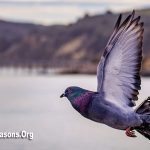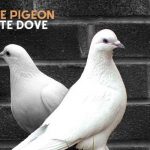With their snowy plumage and red eyes, white pigeons have a very distinctive appearance unlike their grey-toned rock dove cousins. White pigeons exhibit a range of physical traits selectively bred into domestic stocks to produce an elegant, decorative bird. Read on to learn more about the unique physical features and visual qualities of the white pigeon variety.
Plumage Colors
- Pure white feathers covering the entire body are the namesake hallmark of white pigeons.
- Legs are typically bright red, purple, or orange shades rather than grey.
- The cere around nostrils and beak base is white or lightly speckled.
- Eyes are ruby red but can be orange, yellow, or pearl in some genetic strains.
- Beaks range from light horn to dark grey depending on bloodline ancestry.
- Toenails may be light-colored instead of black.
- Some iridescent feather sheens on necks produce a shimmery satin appearance.
| Body Part | Color |
|---|---|
| Feathers | Pure white |
| Legs | Red, orange, purple |
| Beak cere | White, lightly speckled |
| Eyes | Red, orange, yellow, pearl |
| Beak | Light to dark horn |
| Toenails | Light-colored |
Body Structure
- Build is noticeably slimmer and fluffier than feral pigeons.
- Tail feathers are longer and more fanned. Wings may feature longer primary coverts.
- Puffed head feathers create a round cranial appearance.
- Exhibit an upright dignified posture compared to hunched scavenging ferals.
- Overall size ranges from about 10-14 inches tall and over 1 foot long.
- Weigh between 12-18 ounces depending on gender and fitness.
- Sleek body lines give white pigeons a refined aesthetic silhouette.
Temperament
- Selective breeding for docility makes white pigeons very gentle.
- Tend to move slowly and deliberately with little erratic behavior.
- Will eat from the hand and perch calmly for handling.
- Do not startle or panic easily compared to vigilant ferals.
- Relaxed composure and confidence around people.
- Cooing is softer and less frequent than the constant vocalizing of feral pigeons.
- Overall demeanor is more subdued and reserved than their lively cousins.
The pleasing appearance and mellow manners of white pigeons reflect generations of breeding suited to living close with humans.
Image Gallery
Origins of White Pigeons
- White pigeons originated as a color mutation of the wild Rock Dove (Columba livia).
- Naturally occurring albino variants were selectively bred to isolate and propagate the white trait.
- Sustained selective breeding emphasizes certain physical and behavioral traits over generations.
- Isolation from feral populations, controlled mating, and protected living spaces enable intentional development of specialized breeds.
- The white coloration is produced by a lack of melanin pigment in feathers.
- Other breeds have also been developed from rock dove stock for variety in color, size, feathering, and temperament.
Gender Differences
- Males tend to be slightly larger than females overall.
- Males have more iridescent neck plumage while female necks are more white.
- Male ceres are often brighter in color around the nostrils.
- Males make more frequent mating displays like the bowing coo.
- Females exhibit expanded abdominal regions when ready to lay eggs.
The most reliable way to determine gender is observing mating behaviors, as plumage color dimorphism is very subtle between the sexes.
| Characteristic | Male | Female |
|---|---|---|
| Size | Slightly larger | Slightly smaller |
| Neck feathers | More iridescent | More white |
| Cere color | Brighter | Paler |
| Behavior | More displays | Less displays |
| Abdomen | Normal | Enlarged when egg-laying |
Conclusion
So in summary, white pigeons have a very refined and ornamental appearance compared to their wild ancestors, specially developed to match their symbolic cultural niche. Next time you see their flashy white plumage, appreciate that it represents centuries of dedicated breeding efforts to make them so pristine.
- New Jersey Hunting Seasons 2024 New Dates & Regulations - September 15, 2024
- Delaware Hunting & Trapping Seasons Summary 2024 - September 4, 2024
- 2024-2025 Colorado Hunting: New Big Game Season Dates! - August 28, 2024





